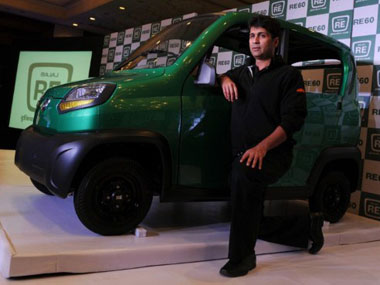New Delhi: Tata Motors today came out in the open against quadricycles, saying the introduction of such vehicles seems to be driven by the belief that they can be cheaper than passenger cars without having the same safety and emission norms which all cars comply with in India.
Perhaps, Tata Motors sees a threat to its Nano if quadricycles are introduced in India without the mandatory safety and emission standards for cars. “The move to introduce quadricyles in India seems to be driven by the belief that they can be cheaper than passenger cars. But, today’s entry level passenger cars have near European Union level safety and emission norms and are yet affordable, as is seen in the growth of entry level cars in the country over the last decade,” a Tata Motors’ spokesperson told Firstpost.
[caption id=“attachment_737685” align=“alignleft” width=“380”] Quadricycles can offer a safer, more comfortable four-wheeled option with doors and seat belts for intra city commute. Reuters[/caption]
Bajaj Auto is the only company right now which wants to offer a product in the quadricycle category. As per Bajaj, this four-wheeler is usually less than half the weight of a small car, can muster up just about a tenth of a car’s horse power and has a maximum top speed of anywhere between 70-80 km an hour compared with a car’s top speed of up to 200 km.
In comparison to three-wheelers though, its top speed and horse power are both higher. Quadricycles can offer a safer, more comfortable four-wheeled option with doors and seat belts for intra city commute. Three-wheelers do not have either doors or seat belts. It is being seen as a replacement of three wheelers by some. A quadricycle, if allowed in its present form of about 400 kg weight and maximum power of 20 horse power, could well be priced somewhere in between a two-wheeler and the Tata Nano and Maruti Alto.
The Tata Motors’ spokesperson went on to warn fatal accidents if safety features are ignored while approving quadricycles. “There are at least 40 critical safety features, applicable to passenger cars in India, which will need to be compromised if the Indian quadricycle emulates the European quadricycle. This will make quadricycles vulnerable to fatal accidents, thereby further deteriorating India’s road safety records. Among critical life-saving features which could be missing with such emulation are protection against the head form impact, body block, frontal crash protection and side door intrusion protection.”
Impact Shorts
More ShortsBut Rajiv Bajaj, the man who wants to bring RE60 in the quadricycle catgeory to India, has been explaining to anyone who cares to listen that his idea to sell a vehicle whose maximum weight does not cross 450 kg. In fact, Bajaj claims he has said as much to the Tyagi committee which is framing quadricycle rules.
“We have proactively proposed this condition which is as in the European regulations too. At both these forums Tata instead has been asking for max weight to be relaxed to 700 kg. This defeats the very purpose of creating the quadricycle category. Unfortunately the Tyagi committee has approved of the 700 kg weight limit. A 700 kg quadricycle’s exhaust emission and fuel efficiency will be no different than that of a small car. That’s why other car makers such as Maruti are correctly objecting to the Tyagi committee’s recommendation,” Bajaj said in an e-mailed response to Firstpost.
The weight a quadricycle Bajaj wants to launch is half the weight of a typical small car. Besies, Bajaj says its “engine is very sophisticated - fuel injected, water cooled, 3 spark plugs, 4 valves, 5 gears……As soon as weight halves, exhaust emissions and fuel consumption halve since the engine now needs to work only half as hard.”
Bajaj said he has already proposed within SIAM as well as to the Tyagi committee that the maximum weight of the quadricycle must be restricted to 450 kg. “We have proactively proposed this condition which is as in the European regulations too. At both these forums Tata instead has been asking for maximum weight to be relaxed to 700 kgs. This defeats the very purpose of creating the quadricycle category.”
The Tata Motors’ spokesperson quoted earlier said that though India seems to be influenced by Europe in the introduction of quadricycles, in Europe itself the sales of quadricycles were a meagre 23,800 in 2011. As a result of increased awareness of their inferior occupant safety compared to normal cars, the three main traditional markets, France, Italy and Spain, have seen their sales fall from a high of 29,000 in 2007 to just 18,000 in 2011. They are at present used either by the very elderly or the very young who do not qualify for regular car driving licences.
So will India put some restrictions on the use of quadricycles? Will it be a car, a safer three wheeler or a new vehicle all together? Will it be allowed to run anywhere on India roads or will it have some restrictions in terms of highway usage? Will it really impact small cars like the Tata Nano, Maruti Alto etc? Will it be taken up for transportation in semi-urban and rural areas and thereby impact even LCVs like Tata Ace?
These questions need to be addressed before the Government finally allows a new category of vehicles to enter Indian roads.


)

)
)
)
)
)
)
)
)



